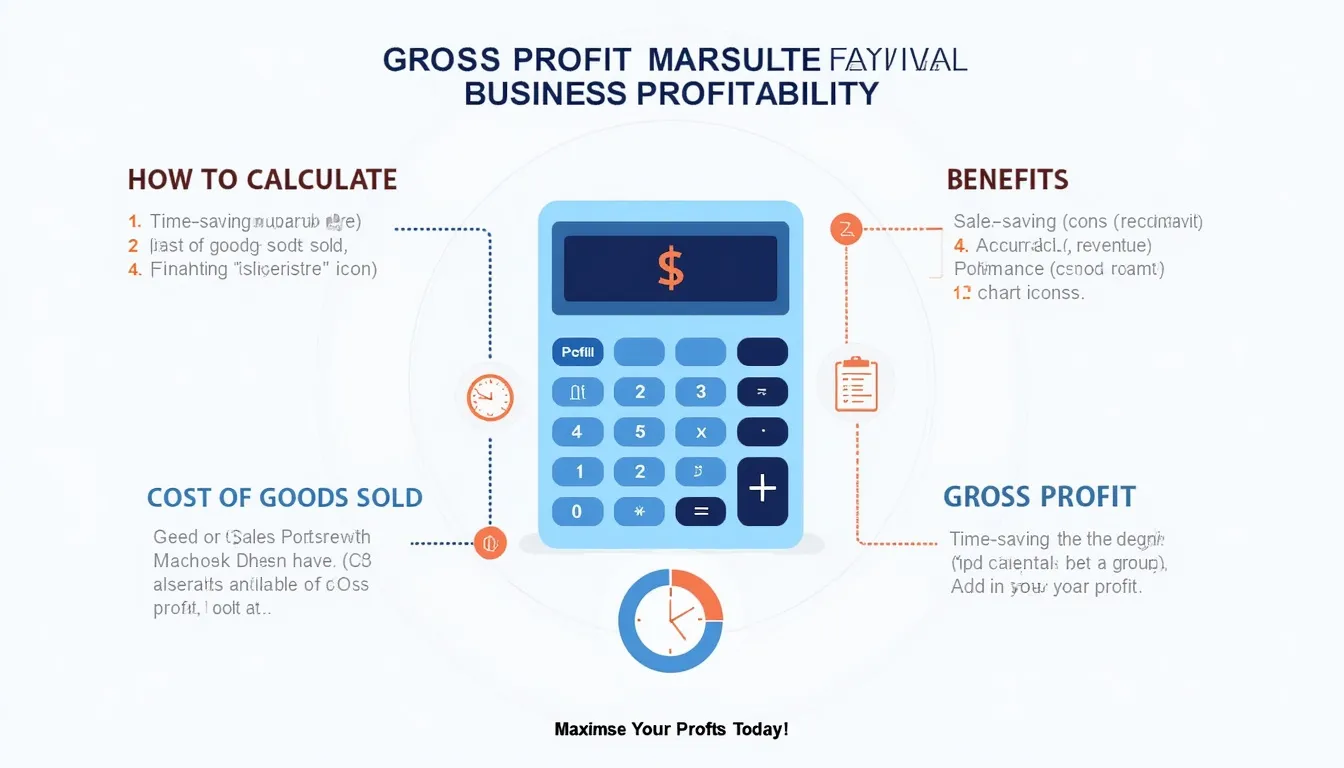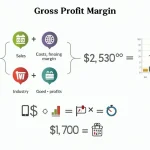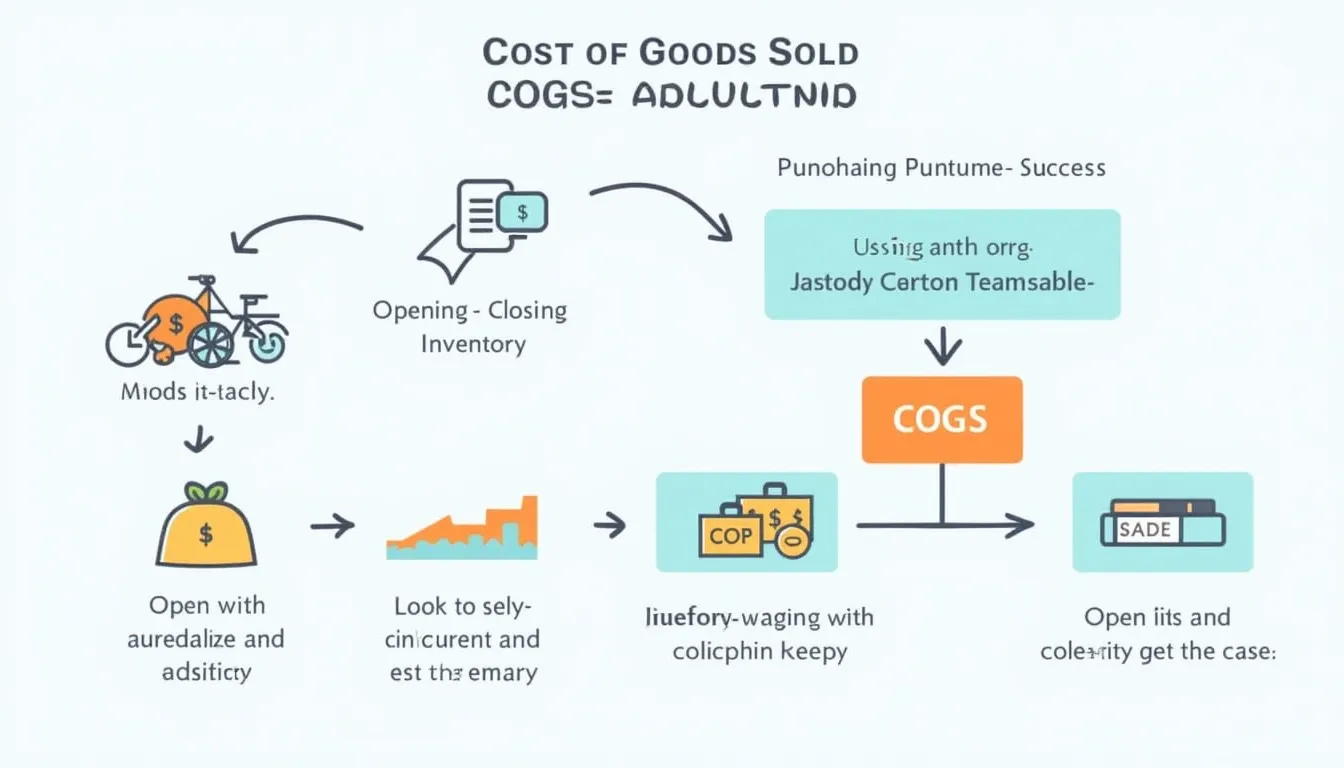Gross Profit Calculator
Is this tool helpful?
How to Use the Gross Profit Calculator Effectively
Our Gross Profit Calculator is a powerful tool designed to help businesses quickly and accurately determine their gross profit. By following these simple steps, you can harness the full potential of this calculator:
- Enter Sales Revenue: Input your total sales revenue for the period you’re analyzing. This should include all income generated from your primary business activities.
- Input Cost of Goods Sold (COGS): Enter the total costs directly associated with producing the goods or services you’ve sold. This typically includes raw materials, direct labor, and manufacturing overhead.
- Click ‘Calculate Gross Profit’: Once you’ve entered both figures, simply click the button to instantly calculate your gross profit.
- Review Results: The calculator will display your gross profit in dollars. This figure represents the difference between your sales revenue and cost of goods sold.
For optimal results, ensure you’re using accurate and up-to-date financial data. Regular use of this calculator can provide valuable insights into your business’s financial health and profitability trends over time.
Introduction to Gross Profit: Definition, Purpose, and Benefits
Gross profit is a fundamental financial metric that plays a crucial role in assessing a company’s profitability and operational efficiency. It’s defined as the difference between a company’s total sales revenue and its cost of goods sold (COGS). In mathematical terms:
$$\text{Gross Profit} = \text{Sales Revenue} - \text{Cost of Goods Sold}$$The purpose of calculating gross profit is to determine how much money a company retains after accounting for the direct costs associated with producing its goods or services. This figure is essential for several reasons:
- It indicates the efficiency of a company’s production process
- It helps in pricing strategies and cost management
- It serves as a basis for calculating gross profit margin, a key profitability ratio
- It provides insights into a company’s ability to cover operating expenses and generate net profit
The benefits of regularly calculating and analyzing gross profit are numerous:
- Financial Health Assessment: Gross profit is a key indicator of a company’s financial health, showing how much money is left over to cover operating expenses and contribute to net profit.
- Operational Efficiency: By tracking gross profit over time, businesses can gauge the efficiency of their production processes and identify areas for improvement.
- Pricing Strategy: Understanding gross profit helps in setting appropriate prices for products or services to ensure profitability.
- Competitive Analysis: Comparing gross profit with industry benchmarks can provide insights into a company’s competitive position.
- Investment Decisions: For investors and stakeholders, gross profit is a crucial metric in evaluating a company’s potential and making informed investment decisions.
Benefits of Using the Gross Profit Calculator
Our Gross Profit Calculator offers numerous advantages for businesses of all sizes. Here are some key benefits:
1. Time-Saving Efficiency
Manual calculations can be time-consuming and prone to errors. Our calculator automates the process, providing instant results and freeing up valuable time for other important business activities.
2. Accuracy and Consistency
The calculator eliminates human error, ensuring accurate results every time. This consistency is crucial for reliable financial analysis and decision-making.
3. User-Friendly Interface
With its intuitive design, even those without extensive financial knowledge can easily use the calculator. This accessibility promotes wider use across different departments within an organization.
4. Real-Time Analysis
The ability to quickly input different figures allows for real-time analysis of various scenarios. This feature is particularly useful for forecasting and strategic planning.
5. Educational Tool
For those new to financial concepts, the calculator serves as an educational tool, helping users understand the relationship between sales revenue, cost of goods sold, and gross profit.
6. Performance Tracking
Regular use of the calculator facilitates easy tracking of gross profit over time, enabling businesses to identify trends and make data-driven decisions.
7. Cost Management
By clearly showing the relationship between sales revenue and COGS, the calculator helps businesses identify opportunities for cost reduction and profit maximization.
Addressing User Needs and Solving Specific Problems
The Gross Profit Calculator addresses several critical needs for businesses and financial professionals:
1. Financial Planning and Budgeting
For businesses engaged in financial planning and budgeting, the calculator provides quick insights into potential gross profit under different revenue and cost scenarios. This aids in setting realistic financial goals and creating accurate budgets.
2. Performance Evaluation
Managers and executives can use the calculator to evaluate the performance of different product lines or business units. By comparing gross profit across various segments, they can make informed decisions about resource allocation and strategic focus.
3. Pricing Decisions
When considering price changes, businesses can use the calculator to immediately see the impact on gross profit. This helps in making informed pricing decisions that balance competitiveness with profitability.
4. Supplier Negotiations
During supplier negotiations, the calculator can quickly show how different cost structures affect gross profit. This information is valuable in determining acceptable price points for raw materials or services.
5. Investment Analysis
Investors and analysts can use the calculator to compare the gross profit of different companies or industries, aiding in investment decision-making.
6. Break-Even Analysis
While not a direct function of the calculator, the gross profit figure is a crucial component in break-even analysis. Users can combine the calculator’s output with fixed cost information to determine break-even points.
Practical Applications and Use Cases
To illustrate the practical utility of the Gross Profit Calculator, let’s explore some real-world scenarios:
Case Study 1: Retail Store Expansion
A small retail chain is considering opening a new store. They use the Gross Profit Calculator to project potential profits under different sales scenarios:
- Scenario A: Sales Revenue: $500,000, COGS: $350,000
- Gross Profit: $150,000
- Scenario B: Sales Revenue: $750,000, COGS: $500,000
- Gross Profit: $250,000
This analysis helps them set realistic goals and determine the viability of the expansion.
Case Study 2: Manufacturing Process Improvement
A manufacturing company is considering investing in new machinery to reduce production costs. They use the calculator to compare current and projected figures:
- Current: Sales Revenue: $1,000,000, COGS: $700,000
- Gross Profit: $300,000
- Projected: Sales Revenue: $1,000,000, COGS: $600,000
- Gross Profit: $400,000
The potential $100,000 increase in gross profit helps justify the investment in new machinery.
Case Study 3: Seasonal Business Analysis
A tourism-dependent business uses the calculator to analyze profitability across different seasons:
- Peak Season: Sales Revenue: $200,000, COGS: $120,000
- Gross Profit: $80,000
- Off-Season: Sales Revenue: $80,000, COGS: $60,000
- Gross Profit: $20,000
This analysis helps in planning for off-season cost reductions and peak season resource allocation.
Case Study 4: Product Line Evaluation
A multi-product company uses the calculator to compare the profitability of different product lines:
- Product A: Sales Revenue: $300,000, COGS: $180,000
- Gross Profit: $120,000
- Product B: Sales Revenue: $250,000, COGS: $200,000
- Gross Profit: $50,000
This comparison helps in deciding which product lines to focus on or potentially discontinue.
Frequently Asked Questions (FAQ)
1. What is gross profit?
Gross profit is the amount of money a company retains after subtracting the costs directly associated with producing and selling its products or services (Cost of Goods Sold) from its total sales revenue.
2. How is gross profit different from net profit?
Gross profit only considers the direct costs of production (COGS), while net profit takes into account all business expenses, including operating expenses, taxes, and interest.
3. Can gross profit be negative?
Yes, gross profit can be negative if the cost of goods sold exceeds the sales revenue. This situation is unsustainable in the long term and indicates serious pricing or cost management issues.
4. How often should I calculate gross profit?
It’s advisable to calculate gross profit regularly, typically monthly or quarterly, to track trends and make timely business decisions.
5. What does a high gross profit indicate?
A high gross profit generally indicates efficient production processes and strong pricing power. However, it should be considered alongside other financial metrics for a comprehensive analysis.
6. Can I use this calculator for service-based businesses?
Yes, for service-based businesses, the ‘Cost of Goods Sold’ would be replaced by ‘Cost of Services Rendered,’ but the principle remains the same.
7. How does gross profit relate to gross margin?
Gross margin is derived from gross profit. It’s calculated by dividing gross profit by sales revenue and is expressed as a percentage.
8. Is a higher gross profit always better?
While a higher gross profit is generally positive, it’s important to consider it in context. Sometimes, a lower gross profit might be acceptable if it leads to higher sales volume and overall profitability.
9. How can I improve my gross profit?
Gross profit can be improved by increasing sales revenue (through higher prices or volumes) or by reducing the cost of goods sold (through more efficient production or better supplier negotiations).
10. Can this calculator be used for all types of businesses?
While the basic principle applies to most businesses, some industries may have specific accounting rules that affect how gross profit is calculated. It’s always best to consult with a financial professional for industry-specific guidance.
Please note that we cannot guarantee that our webtool or the results from our webtool are always correct, complete, or reliable. Our content and tools might have mistakes, biases, or inconsistencies.
Conclusion: Maximizing Business Profitability with the Gross Profit Calculator
The Gross Profit Calculator is an indispensable tool for businesses aiming to maximize their profitability and maintain financial health. By providing quick, accurate calculations of gross profit, it empowers business owners, managers, and financial professionals to make informed decisions about pricing, cost management, and overall business strategy.
Key benefits of regularly using this calculator include:
- Time-saving efficiency in financial calculations
- Improved accuracy in financial reporting and analysis
- Better insights for pricing strategies and cost management
- Enhanced ability to track financial performance over time
- Valuable tool for financial planning and forecasting
In today’s competitive business environment, understanding and optimizing gross profit is crucial for sustainable success. This calculator serves as a powerful ally in that pursuit, offering a user-friendly interface that makes complex financial concepts accessible to all.
We encourage you to make the Gross Profit Calculator a regular part of your financial toolkit. Whether you’re a small business owner, a financial analyst, or a student of business, this tool will provide valuable insights to help you navigate the complexities of business finance.
Start using the Gross Profit Calculator today and take the first step towards more informed, data-driven decision-making for your business. Remember, in the world of business, knowledge is power, and understanding your gross profit is a key component of that knowledge.
Important Disclaimer
The calculations, results, and content provided by our tools are not guaranteed to be accurate, complete, or reliable. Users are responsible for verifying and interpreting the results. Our content and tools may contain errors, biases, or inconsistencies. We reserve the right to save inputs and outputs from our tools for the purposes of error debugging, bias identification, and performance improvement. External companies providing AI models used in our tools may also save and process data in accordance with their own policies. By using our tools, you consent to this data collection and processing. We reserve the right to limit the usage of our tools based on current usability factors. By using our tools, you acknowledge that you have read, understood, and agreed to this disclaimer. You accept the inherent risks and limitations associated with the use of our tools and services.







